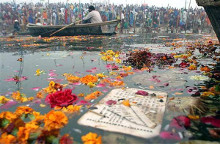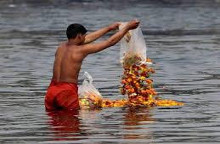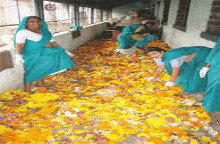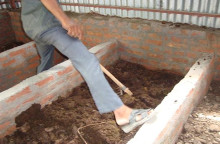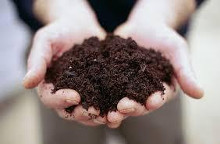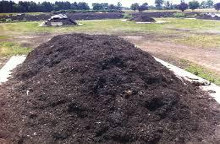Clean and Sustainable Rivers
– Via Flowers (Bio degradable Waste) Processing through Composting units to get manure
Offerings to Holy Rivers
In the Hindu Religion,there is a tradition of offerings to the Holy Rivers. People who normally come for a holy dip in Ganga or Yamuna are generally religious people, who after dip offer flowers, coins, milk, coconut and other materials in below.
A typical scene of river bank and river after offering of flowers and Puja item
Many of these Puja items are biodegradable except coins. Besides, some other type of waste coming in the holy rivers are; ashes or remains after cremation of human body or sometimes discarding the body / or animal asses as such in river. Many times animals also take bath or swim in river and that also pollutes these rivers. All these are the causes of direct pollution of the river Ganga and its tributaries. As Ganga is a holy river and Hindu’s consider it as their mother and thus they in reverence offer flowers etc to it. While bringing the Puja items polythene begs also comes as this is a convenient way of carrying the Puja Items to the banks of river. This is especially seen in Allahabad city and also all along the river Ganga route.
Introduction and Objectives of Project
Holy Ganga river cleaning has been on the priority of Government of India as well as on the state Government of Uttar Pradesh for the last more than 25 years. Further in the last 40 years the nuisance of waste has reached alarming proportions in our country. The Swatch Bharat Abhiyaan, at the National level is trying its best in various ways to help solve this issue. Apart from making elaborate arrangements for cleaning the Ganga and environment, it is imperative that waste is processed at the source or near it. This will go a long way in reducing the waste and cleaning the holy river Ganga.
Biodegradable waste or bio-degradable component of mixed waste can be composted aerobically or digested to produce farm soil improvers and source of renewable fuels. Thus the scheme has the following objectives:-
- Collect all the waste floating on the river surface or otherwise.
- Carrying the waste to processing unit
- Sorting the waste for non and biodegradable items
- Bio degradable waste can be composed to manure form. This compost is most beneficial in farming and thus helps grow healthy food and restoring the health of farm soil. This manure can be sold to users and farmers
- It will provide clean water (Ganga Jal) for a holy dip in river
- It will result in Clean Ganga and eco friendly atmosphere.
Following steps will be carried out for the implementation of Project.
Location and Justification:
The NAPEP unit to process the flower waste has to be located near the source. That is where the waste is generated – it should locate close to it. Thus the transportation of waste coming from holyriver Ganga will not have to transported a long distance. Thus a series of them will be made at a distance of 500 meter on each banks of river.
Capacity of the Composting unit:
Starting first phase we being constructed 500 pits (size 5m x 2.5m with 1m height). These can be covered by a polythene/GI sheet/Fiber sheet/Cemented sheet whatever may be required depending upon budget allocation by funding agency. These sheets will be supported by GI poles.
Other steps involved:
It will involve following steps:
- Collecting the flowers (waste) from river Ganga
- Carrying the waste to processing unit
- Sorting the waste for any non and biodegradable item
- Shredding the waste in smaller pieces and putting it in Pits
- Inserting the Yash Activator Plus or microbial consortium for rapid composting in pits
- Turning the material in pits and spray the water in pits
- sieving
- Taking out the ready material and packing in begs.
The details of some of these steps are given below:
Construction of such units / Chambers
The size of unit may be as follows:
- Length of Pit: 5 m
- Width of proposed Pit: 2.5 m
- Depth of proposed pit: 1 m
- It will be made with Fly Ash or burnt clay bricks. The width of walls will be 230mm or 1 brick thick. It will be laid in cement sand mortar of 1:6 ratio.A typical pit is shown below
Final process of preparing the manure in usable form
After decomposing the waste the ready manure has to be processed. For this some space / shed will be needed. Then it will be packed in the bags of 25 kg each this material may be a property of sponsoring agency. Or it can directly be sold to users / farmers.
Process of Implementation
- Agreement from ‘Ganga Authority’ and implementing agency.
- Total capital cost and 50% of recurring expenses to be released by funding authorities in advance. Balance 50% to be released after 10 days of submission of the Bill on completion of 15 days work.
- Then the implementing organization will begin the work immediately after release of funds. Next phase of work will continue in continuation. Funding agency (Government body who will spent his fund under Namami Gange) will be made acquainted on each weeks progress basis. Enough number of progress reports will be made with photographs and other data.
Disposal/sale of finished manure and remainder Items
Remainder of river waste: The remainder waste after sorting the flowers from it will be dumped at some disposal site or it can be given to the Solid waste management agency of town that may either process it or dump it at suitable places.
Expected Outcome and Benefits
Following will be outcome or benefits of doing this process of collecting the flowers and waste from river Ganga:
- This process will help the holy river Ganga in getting clean water.
- It will generate a byproduct which will be useful in feeding the hungry agricultural soil and help in healthy farming practices.

